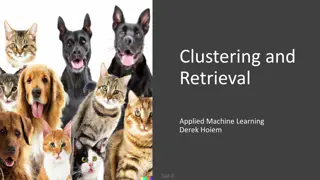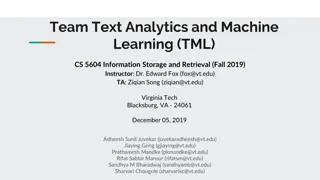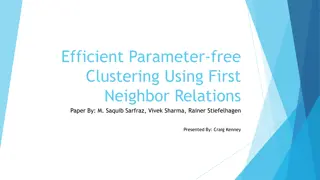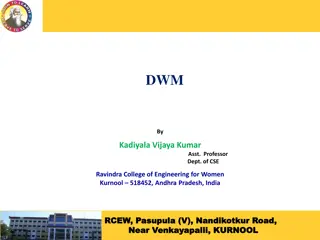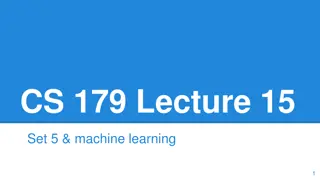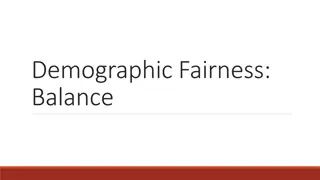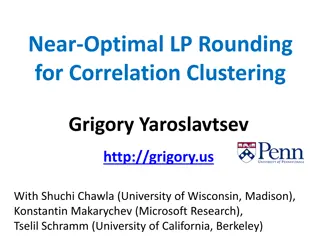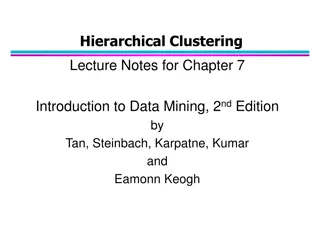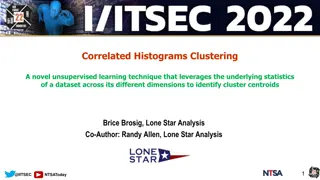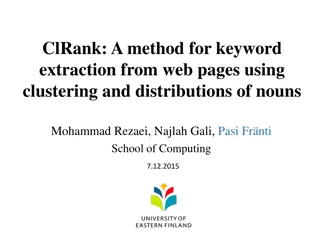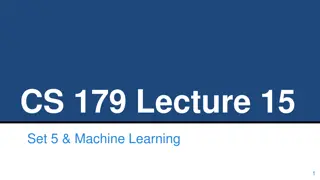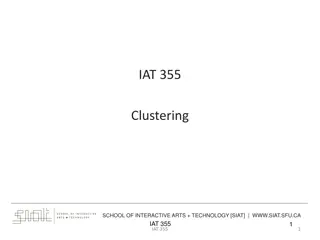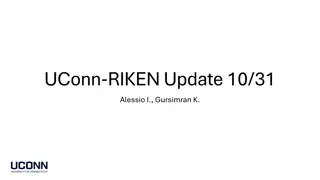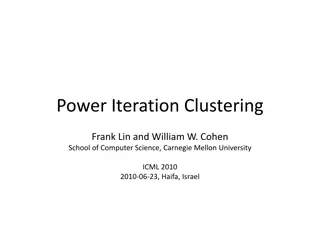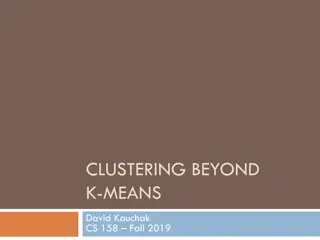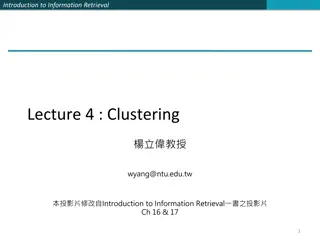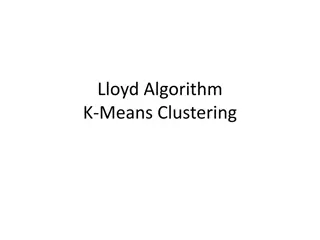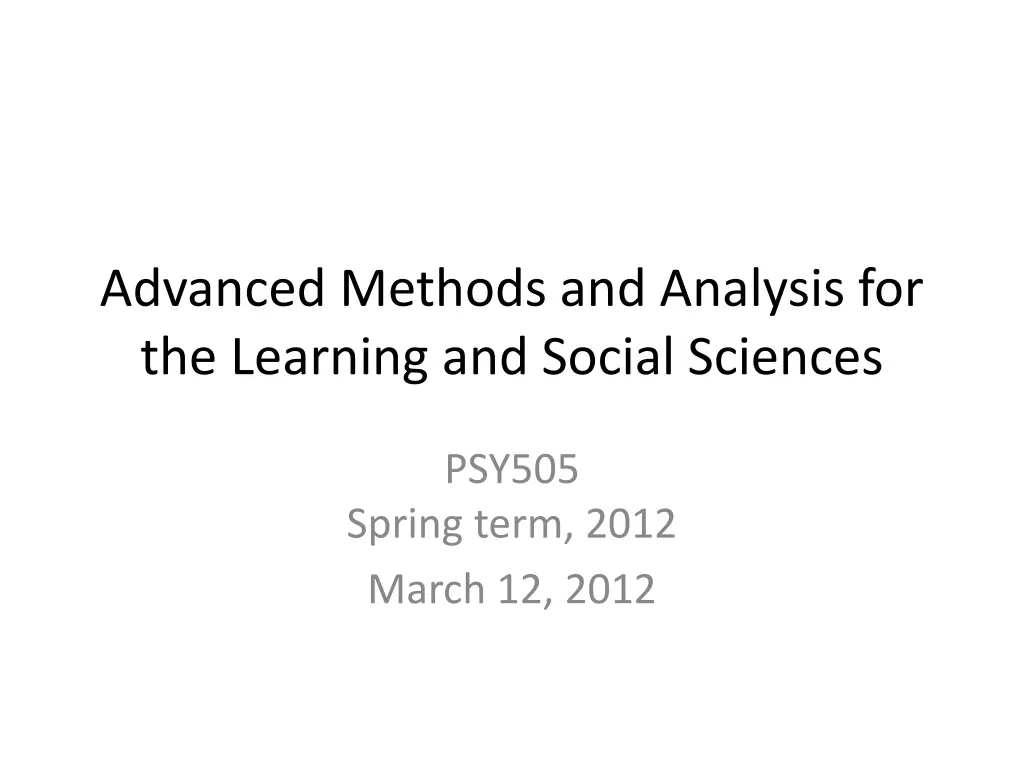
Understanding Clustering in Learning and Social Sciences
Explore the concept of clustering in learning and social sciences, where data points are grouped together based on unknown structures. Discover how clustering allows for the study of various questions and how it differs from factor analysis. Dive into a trivial example and the k-Means algorithm, a simple yet effective clustering technique. Learn about selecting cluster centroids and the process of getting clusters.
Download Presentation

Please find below an Image/Link to download the presentation.
The content on the website is provided AS IS for your information and personal use only. It may not be sold, licensed, or shared on other websites without obtaining consent from the author. If you encounter any issues during the download, it is possible that the publisher has removed the file from their server.
You are allowed to download the files provided on this website for personal or commercial use, subject to the condition that they are used lawfully. All files are the property of their respective owners.
The content on the website is provided AS IS for your information and personal use only. It may not be sold, licensed, or shared on other websites without obtaining consent from the author.
E N D
Presentation Transcript
Advanced Methods and Analysis for the Learning and Social Sciences PSY505 Spring term, 2012 March 12, 2012
Todays Class Clustering
Clustering You have a large number of data points You want to find what structure there is among the data points You don t know anything a priori about the structure Clustering tries to find data points that group together
Clustering What types of questions could you study with clustering?
Related Topic Factor Analysis Not the same as clustering Factor analysis finds how data features/variables/items group together Clustering finds how data points/students group together In many cases, one problem can be transformed into the other But conceptually still not the same thing Next class!
Trivial Example Let s say your data has two variables Pknow Time Clustering works for (and is equally effective in) large feature spaces
+3 time 0 -3 0 1 pknow
k-Means +3 time 0 -3 0 1 pknow
Not the only clustering algorithm Just the simplest
How did we get these clusters? First we decided how many clusters we wanted, 5 How did we do that? More on this in a minute We picked starting values for the centroids of the clusters Usually chosen randomly
How did we get these clusters? First we decided how many clusters we wanted, 5 How did we do that? More on this in a minute We picked starting values for the centroids of the clusters For instance
+3 time 0 -3 0 1 pknow
Then We classify every point as to which centroid it s closest to This defines the clusters This creates a voronoi diagram
+3 time 0 -3 0 1 pknow
Then We re-fit the centroids as the center of the points in the cluster
+3 time 0 -3 0 1 pknow
Then Repeat until the centroids stop moving
+3 time 0 -3 0 1 pknow
+3 time 0 -3 0 1 pknow
+3 time 0 -3 0 1 pknow
+3 time 0 -3 0 1 pknow
+3 time 0 -3 0 1 pknow
What happens? What happens if your starting points are in strange places? Not trivial to avoid, considering the full span of possible data distributions
What happens? What happens if your starting points are in strange places? Not trivial to avoid, considering the full span of possible data distributions There is some work on addressing this problem
+3 time 0 -3 0 1 pknow
+3 time 0 -3 0 1 pknow
Solution Run several times, involving different starting points cf. Conati & Amershi (2009)
How many clusters should you have? Can you use goodness of fit metrics?
Mean Squared Deviation (also called Distortion) MSD = Take each point P Find the center of P s cluster C Find the distance D from C to P Square D to get D Sum all D to get MSD
Any problems with MSD? More clusters almost always leads to smaller MSD Distance to nearest cluster center should always be smaller with more clusters
What about cross-validation? Will that fix the problem?
What about cross-validation? Not necessarily This is a different problem than classification You re not trying to predict specific values You re determining whether any center is close to a given point More clusters cover the space more thoroughly So MSD will often be smaller with more clusters, even if you cross-validate
An Example 14 centers, ill-chosen (what you d get on a cross-validation with too many centers) 2 centers, well-chosen (what you d get on a cross-validation with not enough centers)
+3 time 0 -3 0 1 pknow
+3 time 0 -3 0 1 pknow
An Example The ill-chosen 14 centers will achieve a better MSD than the well-chosen 2 centers
Solution Penalize models with more clusters, according to how much extra fit would be expected from the additional clusters
Solution Penalize models with more clusters, according to how much extra fit would be expected from the additional clusters What comes to mind?
Solution Penalize models with more clusters, according to how much extra fit would be expected from the additional clusters Common approach the Bayesian Information Criterion
Bayesian Information Criterion (Raftery, 1995) Assesses how much fit would be spuriously expected from a random N parameters Assesses how much fit you actually had Finds the difference
Bayesian Information Criterion (Raftery, 1995) The math is painful See Raftery, 1995; many statistical packages can also compute this for you
So how many clusters? Try several values of k Find best-fitting set of clusters for each value of k Choose k with best value of BiC
Lets do a set of hands-on exercises Apply k-means using the following points and centroids Everyone gets to volunteer!
+3 time 0 -3 0 1 pknow
+3 time 0 -3 0 1 pknow

